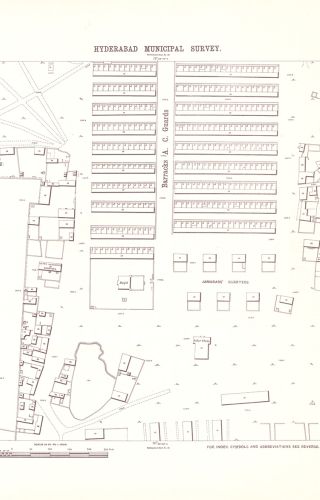There are usually two common responses when I ask if autorickshaw drivers can take me to A.C. Guards. One is ‘Where?’, and usually after mentioning the landmarks of the Mahavir Eye Hospital and the famous restaurant Chicha’s, the driver is more aware. The second, less common one, is ‘Khairtabad?’ Upon reaching A.C. Guards, these drivers are amused because they realise that they did indeed know the place, but were unfamiliar with its name. I wonder, how often these things happen, when we know a place but its name is often of little or no significance to us, that we don’t stop to consider its history. Or we simply take for granted the place of the place, assuming it had been there since time immemorial.
A.C. Guards is named after a regiment of men of Afro-Arabian descent, who were officially called the ‘African Cavalry Guards’ under the sixth and seventh Nizams, Mir Mahboob Ali Khan and Mir Osman Ali Khan, of the erstwhile princely state. The A.C. Guards presented themselves during special celebrations in Hyderabad, for example, the annual Langar procession visits by dignitaries and representatives from British India which included the likes of the Lord and Lady Curzon and the Prince and Princess of Wales between 1905 and 1906. The A.C. Guards also travelled with the Nizam for ceremonies outside of the princely state such as the Imperial Durbars in Delhi. Although these men were called the ‘African’ Cavalry Guards, they had ethnic and familial roots from Abyssinia (parts of present-day Ethiopia and Eritrea) and Zanzibar to the Hadhramaut (present-day Yemen), revealing a tension of what ‘African’ meant during the reigns of Mir Mahboob Ali Khan and Mir Osman Ali Khan.
The Hyderabad Municipal Maps, created between 1912–1915 and published by the Kalakriti Archives on Google Culture and Arts in 2018, gave me an opportunity to catch a glimpse of the history of A.C. Guards before it became organised as a mohalla (community). These maps were the results of a team of engineers and surveyors commissioned by the seventh Nizam, Mir Osman Ali Khan, in the aftermath of the Musi River flood in 1908, what historian Benjamin Cohen characterises as a ‘watershed moment in Hyderabad’s urban history.’[1] Led by English engineer Leonard Munn, the team sought to mark the boundaries of Hyderabad by dividing the princely state into 16 large areas, which included Khairtabad, the area that subsumed the present-day locality of A.C. Guards. Therefore, the map does not recognise A.C. Guards as an independent community or neighbourhood but groups it under the Khairtabad area. Its main identifiers are the barracks, quarters for the jamadars and lower-rung soldiers, the church, and an ashur khana (a sacred site of mourning for Shia Muslims).
I wanted to explore the mohalla with the sketches from the Hyderabad Municipal Map in mind, to see the interplay between a mapping project in the early 1900s to the present-day lived experience of a community bound by various social, cultural, and religious threads. My conversations with residents, however, kept animating questions I had from studying documents in the Telangana State Archives.
As I chatted with some residents, they still expressed great respect for the last Nizam of Hyderabad and attributed his generosity to the construction of the neighbourhood. However, it was interesting to note that from archival documents I studied, under the reign of Mir Osman Ali Khan, the A.C. Guards were reduced to more than half the number of troopers and were considered third-tier in comparison to other military regiments. In 1929, there was a proposal set forth to reorganise the regular forces. This initiative proposed to dissolve the A.C. Guards and split the members of the regiment between two new military cavalry regiments. This plan did not materialise but the A.C. Guards were reduced by half. By 1933, the African Cavalry Guards were known as the African Bodyguard Squadron (A.B.G Squadron), though there is no evidence pointing to when or why this name change took place. ‘Between 1933–1934, the authorized strength of horses for the A.B.G. Squadron was 100’[2] while they had three times that number of horses in former years. The reduction in size and the poor maintenance of their facilities indicate that the usage of ceremonial regiments like the A.C. Guards had altered. Military discipline and action in the battlefield were prioritised in the aftermath of the first World War.
The annexation of the Hyderabad princely state into independent India also brought massive changes in the A.C. Guards. Conversations that I had with residents in the neighbourhood suggest that the regiment was most likely completely dissolved by 1953, upon the institution of Hyderabad’s ‘police action,’ or when the princely state of Hyderabad was forcefully annexed into independent India. Because the A.C. Guards were considered to be a military unit, it is believed that the residents of the neighbourhood receive pensions to-date. But after talking to many descendants, it appears as though this is not the case. They do not receive any form of financial assistance for being the descendants of former military servicemen.
The autorickshaw drivers who came with me to A.C. Guards illustrate the liminal space that the history of the regiment, African Cavalry Guards, occupies: other Hyderabadis do not know them by name, but know that they existed.
Notes
[1] Benjamin. ‘Modernising the Urban Environment: The Musi River Flood of 1908 in Hyderabad, India.’
[2] ‘Report on H.E.H. The Nizam’s Regular Forces,’ iii.
Bibliography
Cohen, Benjamin. ‘Modernising the Urban Environment: The Musi River Flood of 1908 in Hyderabad, India.’ Environment and History 17, no. 3 (August, 2011): 409–32.
Macartney, F. A. ‘Report on H.E.H. The Nizam’s Regular Forces.’ Hyderabad: Nizam of Hyderabad, 1936.













